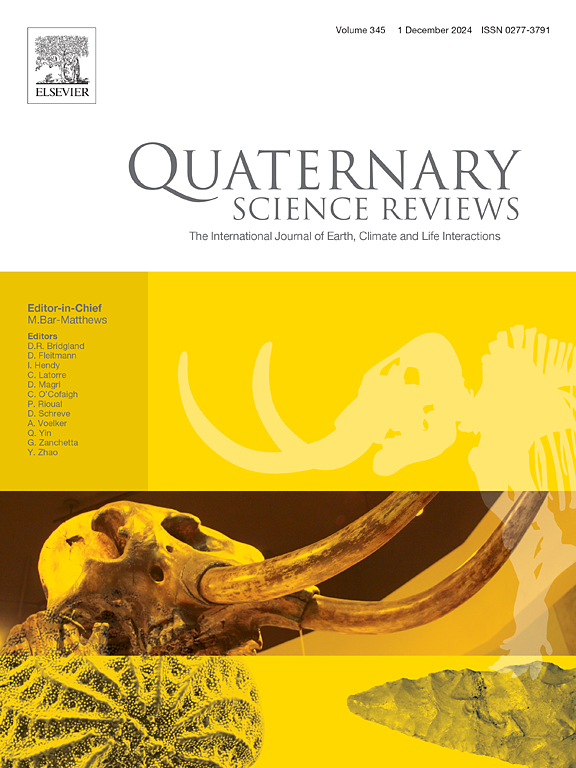Deep north atlantic circulation strength: Glacial-interglacial variability over the last 400,000 years
IF 3.2
1区 地球科学
Q1 GEOGRAPHY, PHYSICAL
引用次数: 0
Abstract
Most of the high-resolution studies investigating the past variability of the deep North Atlantic circulation are focused on recent timescales, but little is known for periods older than the last glacial period. Based on magnetic, elemental and physical grain-size proxies of three pairs of sediment cores located South of Iceland, we reconstructed the past changes in grain-size and basaltic-derived grain concentration over the last 400 ka (1 ka = 1000 years). The source and grain-size proxies exhibit highly similar variations between the three sites, suggesting they are affected by the same regional process. Persistently lower concentrations and finer grain-sizes recorded in the southernmost and deeper site compared to the northern sites indicate a North to South gradient that is consistent with the southward transport of sediments from a northern basaltic source by a deep current. Therefore, we interpret changes recorded by the ensemble of proxies at the three sites as past variations in the ISOW intensity. These new results show persistent influence, over the entire 400 ka, of a southward deep-water flow in the subpolar North Atlantic, from 1800 to 2800 m water depth. The “off mode” of deep Atlantic circulation during Heinrich events suggested by many studies is therefore questioned. This study extends the previous observations made for the 20–65 ka period over the last 400 ka. Our results also show that the three studied sites are bathed by a deep-water mass formed in the Nordic Seas, during both glacial and interglacial periods, suggesting that the present-day convection areas were still active during glacial periods. Our ISOW intensity records are highly similar to those of deep-water ventilation. We propose that the strength of overflows in the North Atlantic regulates the volume of North Atlantic Deep Water (NADW) and its southward transport in the Atlantic basin. Therefore, the Southern source waters may only act as an opportunistic component of the deep Atlantic circulation, invading or retreating depending on the NADW strength.
北大西洋深层环流强度:过去 40 万年冰川-间冰期的变化
大多数调查北大西洋深层环流过去变异性的高分辨率研究都集中在最近的时间尺度上,但对上一个冰川期之前的时期却知之甚少。根据冰岛南部三对沉积岩芯的磁性、元素和物理粒度代用指标,我们重建了过去 400 ka(1 ka = 1000 年)内粒度和玄武岩衍生颗粒浓度的变化。三个地点的来源和粒度代用指标呈现出高度相似的变化,表明它们受到了同一区域过程的影响。与北部站点相比,最南端和最深站点记录到的浓度和粒度持续较低,这表明存在一个由北向南的梯度,与深海洋流从北部玄武岩源头向南输送沉积物的情况一致。因此,我们将这三个地点的代用指标组合所记录的变化解释为过去 ISOW 强度的变化。这些新结果表明,在整个 400 ka 期间,北大西洋副极地水深 1800 米至 2800 米处的南向深水洋流持续产生影响。因此,许多研究提出的海因里希事件期间大西洋深层环流的 "关闭模式 "受到了质疑。这项研究将以前对 20-65 ka 期间的观测结果延伸到了过去的 400 ka 期间。我们的研究结果还表明,在冰川期和间冰期,所研究的三个地点都被北欧海域形成的深水体所覆盖,这表明在冰川期,现今的对流区域仍然活跃。我们的 ISOW 强度记录与深水通气记录高度相似。我们认为,北大西洋的溢流强度调节着北大西洋深水(NADW)的水量及其在大西洋海盆中的南向输送。因此,南源水可能只是大西洋深层环流的一个机会性组成部分,其入侵或撤退取决于 NADW 的强度。
本文章由计算机程序翻译,如有差异,请以英文原文为准。
求助全文
约1分钟内获得全文
求助全文
来源期刊

Quaternary Science Reviews
地学-地球科学综合
CiteScore
7.50
自引率
15.00%
发文量
388
审稿时长
3 months
期刊介绍:
Quaternary Science Reviews caters for all aspects of Quaternary science, and includes, for example, geology, geomorphology, geography, archaeology, soil science, palaeobotany, palaeontology, palaeoclimatology and the full range of applicable dating methods. The dividing line between what constitutes the review paper and one which contains new original data is not easy to establish, so QSR also publishes papers with new data especially if these perform a review function. All the Quaternary sciences are changing rapidly and subject to re-evaluation as the pace of discovery quickens; thus the diverse but comprehensive role of Quaternary Science Reviews keeps readers abreast of the wider issues relating to new developments in the field.
 求助内容:
求助内容: 应助结果提醒方式:
应助结果提醒方式:


